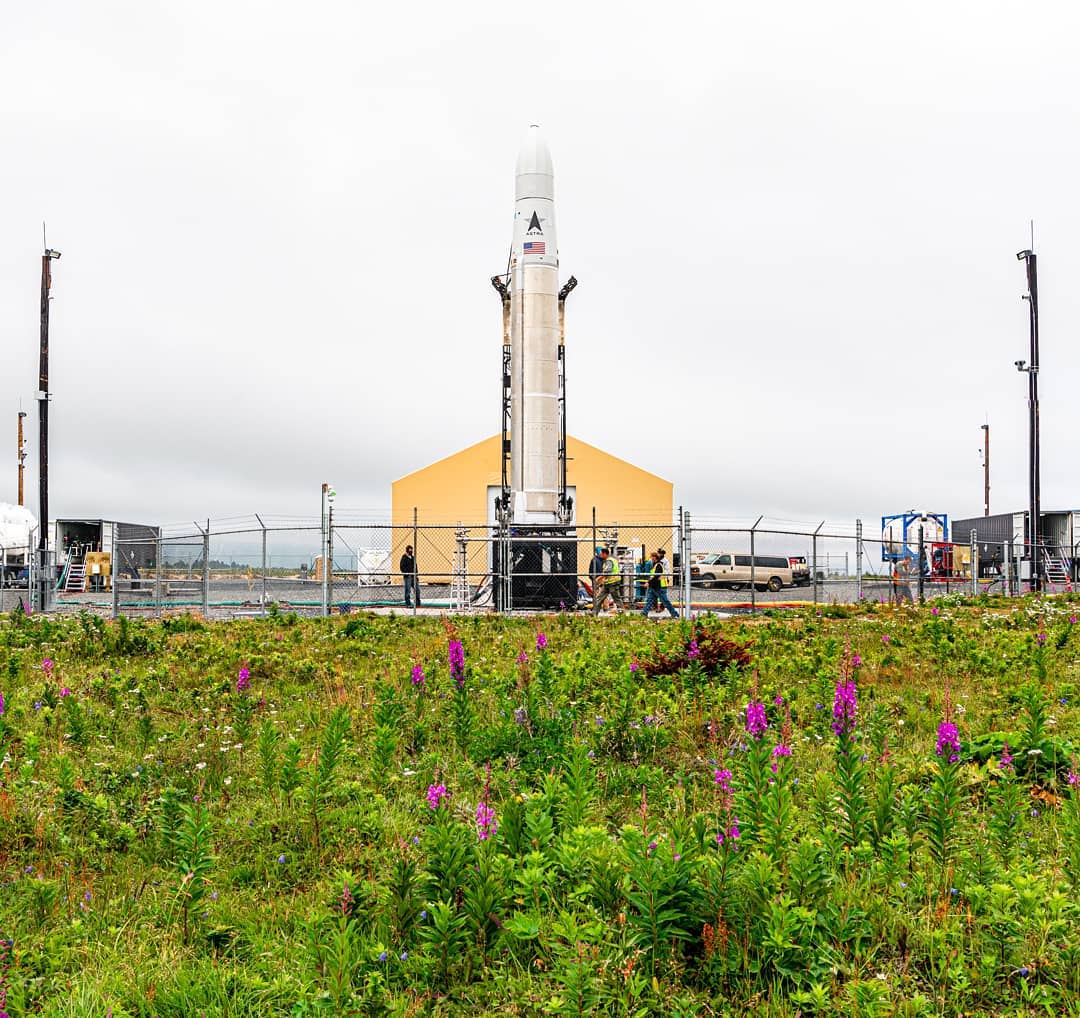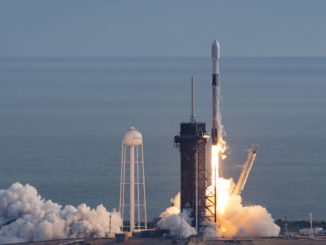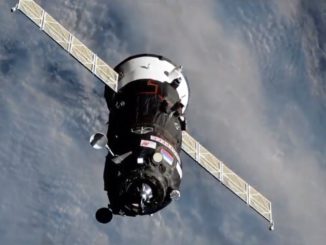EDITOR’S NOTE: Updated Aug. 3 after scrubbed launch attempt. Updated Aug. 4 after second scrub.

After completing a countdown dress rehearsal, Astra is gearing up for its first orbital launch attempt this week from Kodiak Island, Alaska, but company officials said it will likely take multiple test flights before the new small satellite launcher successfully reaches orbit.
Astra’s small satellite delivery vehicle was set for liftoff from the Pacific Spaceport Complex in Alaska during a two-hour window opening at 10 p.m. EDT Sunday (0200 GMT Monday), or 6 p.m. local time in Alaska.
In social media updates, Astra said it fueled the small satellite launcher with liquid propellants Sunday. But officials said out-of-limits upper level winds and a boat in restricted waters offshore of the launch site on Kodiak Island prevented the launch from going ahead Sunday.
Astra scrubbed a second launch attempt Tuesday after encountering a minor technical issue in the countdown. The company says has daily launch opportunities available through Friday, Aug. 7.
The mission is the first of three test flights planned by the privately-funded launch company to eventually reach orbit. Astra calls the launch vehicle awaiting liftoff from Alaska this week “Rocket 3.1.”
Officials said it is unlikely the Rocket 3.1 test flight will enter orbit, although the two-stage vehicle is designed to do so.
Chris Kemp, Astra’s co-founder and CEO, said the company is not intending to hit a “hole-in-one” on the Rocket 3.1 test flight by accomplishing all the milestones necessary to climb into space and accelerate to orbital velocity.
“We intend to accomplish enough to ensure that we’re able to get to orbit after three flights, and for us that means a nominal first-stage burn and getting the upper stage to separate successfully,” Kemp said in a conference call with reporters last week.
Astra shipped the Rocket 3.1 vehicle to Kodiak from the company’s headquarters in Alameda, California, late last month. The company says the compact rocket and its mobile launch pad infrastructure are designed to fit into standard shipping containers to the launch site, where a lean team of engineers and technicians sets up the equipment and performs pre-flight testing.
Astra sent just six people to Kodiak to support the launch of Rocket 3.1, and they were each tested for COVID-19 before the trip, according to Adam London, the company’s co-founder and chief technology officer. Additional teams will oversee the countdown and mission from Astra’s home base in California.
The company completed a “wet dress rehearsal” — in which teams load propellants into the launcher and run through a mock countdown — on the Rocket 3.1 vehicle Friday at Launch Pad 3B at the Alaska spaceport. That sets the stage for Sunday’s launch attempt.
“There will be no payload on this test flight, except for instrumentation on board for data capture,” Astra officials wrote in a press kit for the Rocket 3.1 mission.
London said Astra is not flying a payload on Rocket 3.1 in order to increase performance margins on the vehicle, “and because we believe that’s it’s pretty unlikely that it will work.”
Company officials said Astra will not provide a live video stream of the test launch, but Astra said it plans to provide updates on social media on the status of the mission. Astra said it will also release video and photos after the flight.
“We do not yet employ production, marketing, or communications folks, so our ability to produce a public webcast is limited,” Kemp said in response to questions from Spaceflight Now. “We are focusing all resources on engineering so that we can reach orbit in the next couple of flights.
Founded in 2016, Astra is developing its small satellite launcher using an iterative design process. London said the company places high value on actual flight data, and the upcoming test flights will gather critical information for engineers to make improvements on the rocket, as necessary.
If it was carrying a payload, Rocket 3.1 could deliver 55 pounds (25 kilograms) of cargo into orbit, London said. He added that Astra has a roadmap for more capable rockets, eventually aiming to build a launch vehicle to carry up to 330 pounds (150 kilograms) of payload into orbit.
Kemp said Astra is developing a launch services that is “a lot more affordable” than other small launch companies, such as Rocket Lab. Astra says it will be able to launch small satellites on short notice for the U.S. military and commercial companies.
The design of Rocket 3.1 is based on a launch vehicle named Rocket 3.0 that Astra sent to Kodiak earlier this year for a launch campaign that was part of the Defense Advanced Research Projects Agency’s Launch Challenge. The DARPA Launch Challenge, managed by the Pentagon’s research and development agency, was conceived to incentivize development of new responsive commercial U.S. launch systems.
The deadline for the first Astra mission under DARPA’s Launch Challenge was March 2. After several weather delays and other schedule slips in late February, Astra fueled its Rocket 3.0 vehicle at Kodiak on the final day of the challenge March 2.
But Astra scrubbed a launch attempt due to suspect data from a fuel tank during pressurization of the rocket’s propellant system for liftoff.
That ended Astra’s shot at winning the DARPA Launch Challenge, but the company resolved the problem and was preparing for another launch attempt with Rocket 3.0 later in March. However, an issue with a valve on the rocket led to an over-pressurization and destroyed the vehicle while Astra was draining propellants after a wet dress rehearsal.
Rocket 3.1 measures 38 feet (11.6 meters) tall, and uses engines fed by kerosene and liquid oxygen propellants. Astra makes the rocket out of metallic structures, which the company says are less expensive to produce than lighter carbon fiber materials used on some launch vehicles.
Five Delphin engines on the first stage will cumulatively generate about 31,500 pounds of thrust to power Rocket 3.1 off the pad at Kodiak and toward the south over the Pacific Ocean.
The first stage engines, using electric turbopumps, will burn for 2 minutes and 18 seconds before shutting down. The rocket’s payload fairing will jettison 2 minutes and 20 seconds after liftoff, followed by separation of the first stage 2 minutes and 27 seconds into the mission, according to Astra.
Astra officials said they would be pleased if the mission succeeded until stage separation.
If the rocket is performing well, a single upper stage Aether engine will ignite 2 minutes and 37 seconds after liftoff and produce about 700 pounds of thrust for a burn lasting more than six minutes to reach a relatively low 211-mile-high (340-kilometer) orbit with an inclination of 86.3 degrees.
A payload separation signal from the rocket’s computer is programmed to occur at T+plus 8 minutes, 51 seconds, but no satellites are aboard the launch vehicle.
Email the author.
Follow Stephen Clark on Twitter: @StephenClark1.



